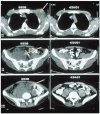Adoptive-cell-transfer therapy for the treatment of patients with cancer
- PMID: 12951585
- PMCID: PMC2305722
- DOI: 10.1038/nrc1167
Adoptive-cell-transfer therapy for the treatment of patients with cancer
Abstract
Adoptive immunotherapy--the isolation of antigen-specific cells, their ex vivo expansion and activation, and subsequent autologous administration--is a promising approach to inducing antitumour immune responses. The molecular identification of tumour antigens and the ability to monitor the persistence and transport of transferred cells has provided new insights into the mechanisms of tumour immunotherapy. Recent studies have shown the effectiveness of cell-transfer therapies for the treatment of patients with selected metastatic cancers. These studies provide a blueprint for the wider application of adoptive-cell-transfer therapy, and emphasize the requirement for in vivo persistence of the cells for therapeutic efficacy.
Figures


References
-
- Shastri N, Schwab S, Serwold T. Producing nature’s gene-chips: the generation of peptides for display by MHC class I molecules. Annu Rev Immunol. 2002;20:463–493. - PubMed
Publication types
MeSH terms
Substances
Grants and funding
LinkOut - more resources
Full Text Sources
Other Literature Sources
Medical

